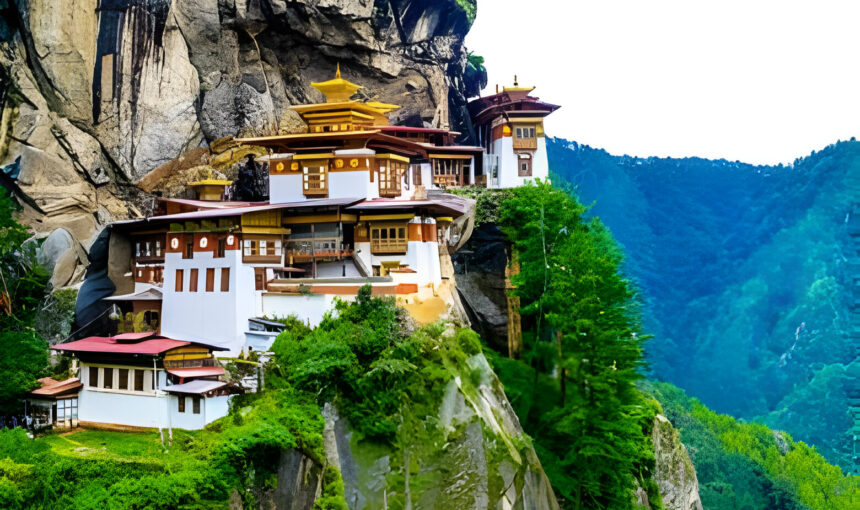🏞️ 1. Paro
Tiger’s Nest Monastery (Taktsang): Iconic cliffside monastery, a spiritual and scenic highlight.
Rinpung Dzong: A fortress-monastery with beautiful architecture and views.
National Museum of Bhutan: Offers insights into Bhutanese history and culture.
🏔️ 2. Thimphu (Capital City)
Buddha Dordenma: Massive golden Buddha statue overlooking the valley.
Tashichho Dzong: Government and monastic center with impressive architecture.
Folk Heritage Museum & Textile Museum: Great for cultural immersion.
🌿 3. Punakha
Punakha Dzong: Stunning fortress at the confluence of two rivers; beautiful in spring with blooming
jacarandas.
Suspension Bridge: One of the longest in Bhutan, offering great views.
Chimi Lhakhang: The “Fertility Temple,” known for its unique legends and blessings.
🌲 4. Phobjikha Valley (Gangtey)
Famous for black-necked cranes in winter.
Serene valley with trekking opportunities and the beautiful Gangtey Monastery.
🌸 5. Bumthang Valley
Cultural heartland with ancient temples and monasteries.
Visit Jakar Dzong, Kurje Lhakhang, and try local cheese and buckwheat noodles.
🛤️ 6. Haa Valley
Off-the-beaten-path destination with scenic beauty and traditional villages.
Visit Lhakhang Karpo and Nagpo (White & Black Temples).
🚶♂️ 7. Trekking & Nature Trails
Druk Path Trek: Between Paro and Thimphu, offers great views and remote lakes.
Snowman Trek: One of the hardest treks in the world – for serious adventurers.Dagala Thousand Lakes Trek: Scenic with panoramic views and remote lakes.
🌟 1. Paro Tshechu
· When: March or April (Spring)
· Where: Paro
·
Highlights:
o One of the biggest and most popular festivals.
o Features mask dances, traditional music, and the unfurling of the giant Thangka
(Thondrol) of Guru Rinpoche.
o Locals dress in their finest traditional clothes.
🌟 2. Thimphu Tshechu
· When: September or October (Autumn)
· Where: Thimphu, the capital
·
Highlights:
o Held in the courtyard of Tashichho Dzong.
o Several days of masked dances, rituals, and religious drama.
o Great for experiencing Bhutanese culture and social life.
🌟 3. Punakha Drubchen and Tshechu
· When: February or March
· Where: Punakha Dzong
·
Highlights:
o The Drubchen includes a dramatic reenactment of the 17th-century battle against
Tibetan invaders.
o The Tshechu follows with traditional mask dances and rituals.
🌟 4. Jambay Lhakhang Drup
· When: October or November
· Where: Bumthang
·
Highlights:
o One of the oldest festivals in Bhutan.
o Known for the mysterious “fire ceremony” and “naked dance” performed by monks
to bless infertile women.
o Deeply spiritual and unique in tradition.🌟 5. Trongsa Tshechu
· When: December or January
· Where: Trongsa Dzong
·
Highlights:
o Traditional dances and religious rituals in the largest dzong in Bhutan.
o Less crowded, giving a more intimate and authentic experience.
🌟 6. Haa Summer Festival
· When: July
· Where: Haa Valley
·
Highlights:
o Celebrates nomadic and agricultural traditions.
o Includes folk songs, dances, yak shows, traditional sports, and local cuisine.
o A great festival for cultural immersion in rural Bhutan.
🌟 7. Black-Necked Crane Festival
· When: November 11 (same as Bhutan’s National Day)
· Where: Phobjikha Valley
·
Highlights:
o Celebrates the arrival of the endangered black-necked cranes.
o Features environmental awareness programs, songs, dances by school children, and
cultural performances.
🌟 8. Talo Tshechu
· When: March or April
· Where: Talo Monastery, Punakha
·
Highlights:
o Celebrated in a serene hilltop monastery.
o Known for the graceful dances of the Talo women.
o A peaceful and beautiful setting for a Tshechu.
🌟 9. Mongar and Trashigang Tshechus
· When: November or December
· Where: Eastern Bhutan
·
Highlights:
o Rich in Eastern Bhutanese culture.o Colorful dances and strong community participation.
o A great way to experience Bhutan beyond the tourist trails.
💡 What Happens at a Tshechu?
·
Cham dances (masked dances) represent stories from Buddhist mythology and the life of
Guru Rinpoche.
· Traditional music and instruments like the lingm, dramyen, and dungchen are played.
·
Blessings are given by monks, and relics or scrolls (Thondrols) are unfurled for public
viewing.
🎉 Why Attend a Bhutanese Festival?
·
Experience living Buddhist culture.
· Witness vibrant traditional costumes.
·
Feel the strong sense of community and spiritual devotion.
·
Perfect for photography, cultural learning, and storytelling.
🌄 Top Tourist Destinations in Bhutan
🇧🇹 1. Paro
·
Must-See:
o 🏞️ Tiger’s Nest Monastery (Paro Taktsang) – Iconic cliffside monastery.
o 🏰 Rinpung Dzong – Beautiful fortress with a museum.
o ? Kyichu Lhakhang – One of the oldest temples in Bhutan.
· Why Visit? Stunning valley views, rich cultural heritage, and the starting point for many
treks.
🇧🇹 2. Thimphu (Capital City)
·
Must-See:
o 🗿 Buddha Dordenma – Gigantic golden Buddha statue.
o 🏯 Tashichho Dzong – Administrative and religious fortress.
o 🎨 National Folk Heritage Museum & Textile Museum.
o 🛍️ Craft Bazaar & Weekend Market.
· Why Visit? Blend of tradition and modernity, with lots of culture to explore.
🇧🇹 3. Punakha·
Must-See:
o 🏯 Punakha Dzong – The most majestic dzong in Bhutan.
o 🌉 Suspension Bridge – One of the longest in the country.
o 🌸 Visit during spring for cherry blossoms and jacarandas.
· Why Visit? Serene river valley, historical significance, and warm climate.
🇧🇹 4. Bumthang Valley
·
Must-See:
o ? Jambay Lhakhang & Kurjey Lhakhang – Sacred temples.
o 🏰 Jakar Dzong – “Castle of the White Bird.”
o 🍶 Try local cheese and red panda beer.
· Why Visit? The spiritual heart of Bhutan, full of myths and sacred sites.
🇧🇹 5. Gangtey (Phobjikha Valley)
·
Must-See:
o 🌿 Black-Necked Crane Center.
o ⛩️ Gangtey Monastery.
o 🚶 Gangtey Nature Trail – Scenic hike through the valley.
· Why Visit? Breathtaking natural beauty, rare wildlife, and peace.
🇧🇹 6. Haa Valley
·
Must-See:
o 🏔️ Chele La Pass (on the way) – The highest motorable pass in Bhutan.
o ? Lhakhang Karpo & Nagpo – White and Black temples.
· Why Visit? Offbeat destination with raw, untouched landscapes.
🇧🇹 7. Trongsa
·
Must-See:
o 🏯 Trongsa Dzong – Strategically located fortress overlooking the valley.
o 🏛️ Royal Heritage Museum – In the old watchtower (Ta Dzong).
· Why Visit? Historical significance and panoramic views.
🇧🇹 8. Trashigang·
Must-See:
o 🏯 Trashigang Dzong.
o ? Gom Kora – Sacred pilgrimage site near the river.
· Why Visit? Gateway to eastern Bhutan, less touristy and full of local charm.
🇧🇹 9. Lhuntse & Mongar (For offbeat travelers)
·
Highlights:
o Remote monasteries, weavers making Kushutara (traditional textiles).
o Rugged beauty, strong local traditions.
· Why Visit? True immersion in rural Bhutanese life.
💡 Extra Experiences You Shouldn’t Miss
· 🍽️ Try Ema Datshi (chili and cheese dish), suja (butter tea), and local yak meat dishes.
· ? Attend a morning prayer session in a monastery.
· 🛍️ Buy traditional hand-woven textiles and Buddhist artifacts.
· 🎯 Try archery, Bhutan’s national sport!
📅 Best Time to Visit Bhutan
· Spring (March–May): Flowers bloom, clear skies – perfect for trekking.
· Autumn (Sept–Nov): Great weather and many festivals.
· Winter (Dec–Feb): Crisp skies and fewer crowds – best for cultural trips.
🌸 Spring (March to May) – Best Overall
· Weather: Pleasant, clear skies, temperatures between 15°C to 25°C
·
Highlights:
o Rhodedendrons and wildflowers in full bloom 🌼
o Best season for trekking (like Jomolhari or Druk Path treks)
o Major festivals like Paro Tshechu
· Why Go? Beautiful landscapes + festive vibe + comfortable climate
🍁 Autumn (September to November) – Another Best Time
· Weather: Crisp, clear days, temperatures between 12°C to 22°C
·
Highlights:
o Stunning views of the Himalayas
o Best time for photography and cultural travel
o Famous festivals like Thimphu Tshechu & Wangdue Tshechu
· Why Go? Ideal for culture, sightseeing, and hikes☀️ Summer (June to August) – Offbeat & Green
· Weather: Warm and rainy (monsoon), temperatures between 17°C to 27°C
·
Highlights:
o Lush green valleys, fewer tourists
o Haa Summer Festival in July
· Why Go? Great if you prefer solitude, greenery, and local festivals — just pack rain gear!
❄️ Winter (December to February) – Quiet & Scenic
· Weather: Cold but sunny, especially in the west; temperatures drop to 0°C in some areas
·
Highlights:
o Peaceful travel with fewer crowds
o Beautiful snow-capped mountains
o Punakha Tshechu & Trongsa Tshechu
o Great for birdwatching in Phobjikha (Black-necked Crane Festival in Nov)
· Why Go? Ideal for a quiet, cultural, and scenic retreat
✅ Summary: Best Months by Travel Type
Travel Type
Best Months
General sightseeing March–May, Sept–Nov
Festivals
March, Sept, Oct
Trekking
April, May, Oct
Offbeat travel
June–Aug, Dec–Feb
Photography
Oct–Nov, March–May

